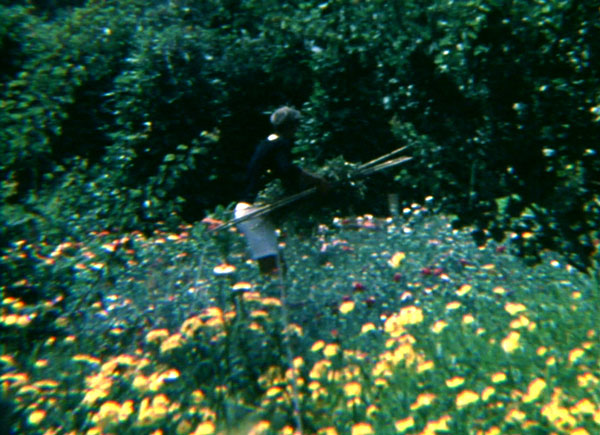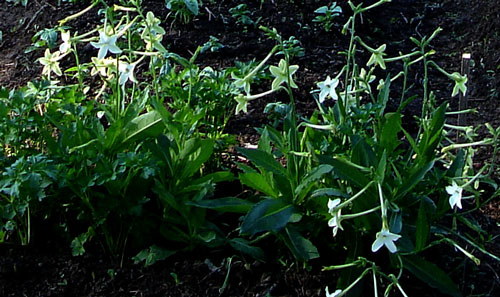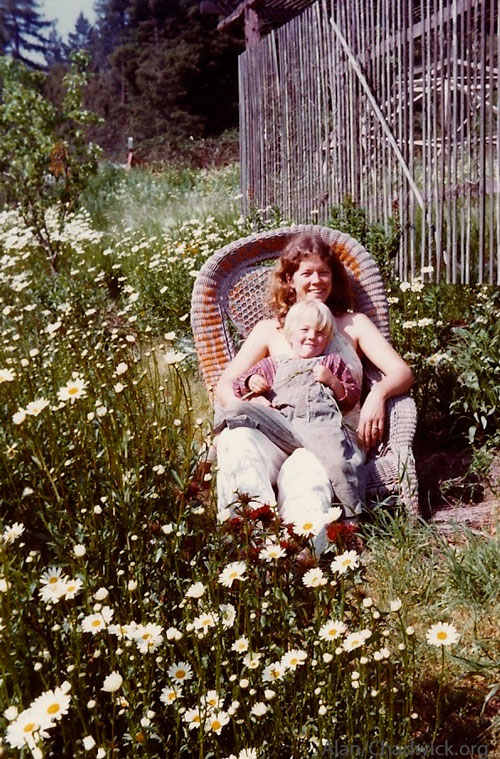Beth Benjamin Remembers Alan Chadwick

By Beth Marie Benjamin, October 17, 2012
Beth Benjamin was an early apprentice to Alan Chadwick in the garden at Santa Cruz. She later went on to create, with her husband, Jim Nelson, and several associates, the gardens at Camp Joy in Boulder Creek. Beth originally wrote this piece as her "Introduction to The Chadwick Garden Anthology of Poets," edited by Robin Somers, and published by the Friends of the UCSC Farm & Garden, 2009.
Alan Chadwick working near a carnation bed, Santa Cruz, 1971. Photo by Michael Stusser
The Chadwick Garden 1967/1968
Late September, 1967. We drove through the gauzy edges of the fog bank that lay over the town of Santa Cruz. Trunk filled with carefully chosen college outfits, most never to be worn again, the car skirted the golden fields and rounded the curve in the road that separated Cowell and Stevenson from my college, Crown, dorm rooms newly painted, awaiting the first crop of students. There, in the shining afternoon sun, above the steep embankment below the college – what was that place, all that color? A brilliant blooming hedge of 4 foot zinnias, stretching hundreds of feet along the top of the bank, was backed by another row of what I learned were tithonia, Mexican sunflowers – crayola orange, velvety grey-green hollow stems, favorite of the monarch butterfly. Alan Chadwick and his crew of summer workers had sown the seeds, and planned and planted this great flowering wall that delineated the lower edge of the garden; a blazing beacon to welcome incoming students I’m sure, but just as much for the butterflies, and the little wasps and all the other flying visitors that were called to the riotous hillside.

For many weeks as I struggled with homesickness and homework and the newly found freedom to stay up all night and still try to make it to class at 8:00 in the chilly dripping morning fog, I wondered about that place on the hill. As spring came, I began to attend a meditation class that was held in the garden, on the porch of the garden chalet. I’d open my eyes to the light after my seventeen year old soul was soothed by stillness, and see the young roses, the birds that hopped on the deck, the shimmer of the ocean far down the hillside and visible from where we sat. This was what I wanted – this beauty, this life, this peace.
Zinnias in the Alan Chadwick Garden at UCSC
Soon I knew I’d rather be working in the garden with eyes open, than sitting on the porch. The man who directed the garden turned out to be a dramatic and charming Englishman in his late 50’s named Alan Chadwick. Tanned like ruddy leather, dressed in crisp nautical blue and white, often only shorts and boots, with a shock of gray hair that he’d toss back abruptly, he’d always be working somewhere. I’d come down the path to find him and say “I’d like a job.” Leaning on the spade, tilting his head to the side like the blue jay that would perch on the handle when he left it to go pull a hose, his blue eyes would sparkle. “Heavy or light?” he’d ask me. I always wanted a heavy job because I wanted to prove to him that girls could work as hard as anyone. I’d push the wheelbarrow up those steep paths, and dump the compost onto a carrot bed-to-be, panting and sweating, but not tipping it over.
Time spent in the garden became the only reality for me. Classes, tests, papers – I couldn’t hold them in focus at all. By spring break, I was spending almost all of my time there with the small and dedicated cadre of workers who’d fallen in love with the man and the site and placed themselves at his service. I took a leave of absence from the university and told my parents that this was what I wanted to do. They determined he was not a cult leader, and gave their blessing. By then I’d met my life partner and moved out of my dorm room into a circle of redwoods in the forest just outside the garden fence. We spread our sleeping bags in that shady cathedral grove and I brushed out the blankets vigorously every night before we got in, exhausted from the day’s labors, eating parsley that grew along the path on the way to our bed. It was typical of Alan that he didn’t even seem to notice or care that we were living in the woods. Periodically some university disturbance about non-students working in the garden and taking advantage of student privileges would arise, but it blew over our bent heads as the beautiful beds and borders continued to take shape, carved from the steep chaparral slope that Alan had chosen to work on. The campus cops would look the other way – I’m sure they knew we were sleeping just outside the garden gate. Who knows what drove their benign neglect?

Beth Benjamin, Off to College, 1967
I learned that Alan had come to Santa Cruz at the request of an old friend of his who was the companion of a visiting professor of Humanities. Several of the professors realized eventual development was going to change the beautiful Cowell Ranch property drastically, and decided to build a garden at its center. Freya von Moltke and her first husband had been involved in the resistance movement and planning the reconstruction of Germany at the inevitable end of the Second World War. Before he was executed, Count von Moltke had entrusted her to establish a place where people could learn of beauty and creation to counter the forces of so much destruction in the world. Here was the opportunity to create such a memorial. She told the professors that she knew just the person to build a garden. He came from a wealthy eccentric family in England, had studied horticulture as a youth, been a painter, a violinist and a Shakespearean actor, and managed the British Embassy gardens in South Africa after leaving his theater when apartheid became law. Alan came grudgingly. The fog in Santa Cruz caused a great deal of discomfort to his back which had been injured in the war. He had never taught students before, he had ordered crews around. He couldn’t be hired as he was not a citizen or a credentialed professor so he had to register as a student, and pay out-of-state tuition, and even write papers (with the help of one of the student gardeners)! But he accepted the task, and began to dig.
All the while, there was support from some on campus, and suspicion from others. At this time, the term “organic gardening” was just beginning to be heard, mostly in “crackpot” magazines from the Rodale Press. There were those in high places who worried about their “in loco parentis” responsibilities and allowing the students to be influenced by this mad magic man who talked about astrology and fairy tales and the “Revolutionibus”. “Of course there are Undines and Fairies and Elves!” he once began a lecture. I know the politics of this juxtaposition were complex, but most of us who worked with him were almost completely free from them Every now and again some issue would generate a whirlwind that would catch us all up in it – for instance when the university decided to take part of the nursery garden and the woods next to it to build the provost’s house. For weeks, we hatched plans at lunch of leaving once and for all to sail off to the Seychelles Islands, on the other side of the globe, which he described with great enthusiasm as a place we could build a better garden in a much more felicitous climate. It was exciting and unsettling – gardeners need to feel the future is settled in order to proceed with the work of the present – and in the end, we moved the fence and the perennials, and carried on.
We performed our daily labors by the rhythm of the sun and the season, like members of a garden monastery or fellows of St. Francis. We felt total allegiance to Alan in his working out of the sacred task laid upon him by his friend Freya. He talked of “sensitivity, observation, and obedience to the laws of nature” – what a concept for California kids in the late 60’s! Alan’s teachings fell on fertile ground; his students had been steeped in John Muir, Rachel Carson and Aldo Leopold, and were about to read Wendell Berry. We knew our work was in response to the needs of the plants that Alan painstakingly taught us to assess, and we also knew this was about something larger than vegetables. The Vietnam War was still raging, and for all of us it was a defining issue of our tumultuous time. It was such a relief to be shown a role for humankind of nurturing the earth and to be stewards of this growing garden on this particular piece of land. His unbending insistence on proper techniques and the acquisition of a discipline based on authority beyond human rules and regulations was novel. The idea that one could live a life based on the garden was enlightening.

I remember going down to Stevenson College to water and tidy up some flower beds laid out around a cluster of dark redwood trees. Alan had planted tall starry nicotiana. In the dusk, the whir of the wings of the hummingbird moth were startling. Breathing in the perfume of the evening-flowering white tobacco, I sensed the plant was as aware of me as I of it. This awareness of having a place in the life of the natural world was Alan’s gift to those of us who worked with him. He helped us realize that plants are alive, they give us everything, and to think of the soil as the skin of the earth and treat it with tenderness.
Nicotiana Afinis, night-flowering tobacco
That summer Alan rented a nearby house for us. We’d drive, or some would walk, through the woods to the garden to arrive as it got light enough to see. We began cutting flowers before the sun came out, before the bees took the pollen and shortened the vase life. We cut cornflowers, ruffled poppies, yellow coreopsis on their long slender stems, giant disbudded dahlias, fragrant sweet peas, airy annual gypsophila and carried them in deep buckets down the steep rock path into the shady kiosk across the road. The soft mornings were filled with the sound of mourning doves and quail calling “Papaver, papaver!” and the snipping of secateurs. Later, students and secretaries would idle their cars and take flowers from the buckets to their dorms and offices. Nothing was sold. No one was paid. The labor was love.
Each day began and ended the same. Watering, picking flowers, double digging the clay soil to form the long, wide beds that were dressed with compost, bone meal, wood ash, whatever the crop required. There would be strong coffee in the mornings, Medaglia d’Oro – bought from Shoppers Corner, and made not in a percolator, but in one of those glass globes. We cooked in the chalet on a hot plate then, and ate on a picnic table on the porch, and washed up afterwards in the cement drainage ditch that ran along the top edge of the garden. . The newly formed Friends of the Farm and Garden donated some money that paid for food, but in the beginning Alan shared the bread and cheese from his basket to supplement the vegetables that came from the garden. Sprinklers set, we’d gather for breakfast. I remember in the summer, Alan frying tomato slices in butter, breaking in eggs from the chickens we kept in a coop at the bottom of the nursery area beneath the big fir tree, then a big handful of chopped parsley – a proper English breakfast I’d never seen before. And bread – even the bread would bring up a fascinating discussion of the difference between good real whole-grain bread, and the white fluff available in the emporium. Then back out into the beds to move the sprinklers again and take up the day’s work until the conch blew for lunch. .
And then in the late afternoon, as the sun’s rays slanted through the bean trellis, we’d set sprinklers again, and someone would put the kettle on. When it boiled, we’d gather for tea (Earl Grey of course, with sweetened condensed milk, none of that pale herbal nun’s tears) and teaching and stories; then back to work and watering until it was too dark to see.
It wasn’t always peaceful; Alan was a challenge. We watched closely and were alert for his mercurial moods. Sometimes on a foggy morning, he’d fire teacups that someone had left from the night before out the door. When he was in physical pain (often, due to the chilly fog) or cross for whatever reason, the great storm clouds would gather. If a student with his head in the clouds and no sense of where his feet were came to the garden for a peaceful stroll, and didn’t notice that he was sinking into the loosely tilthed soil of a new carrot bed, he’d likely be brought to the present by a loud voice and look up startled to notice an angular man loping down the path shouting angrily “Get out! Get out!” Many were intimidated. But when Alan was happy, there was no one I had ever seen who could convey delight so well. The sun would shine from his being onto all of us as we sat on the chalet porch at tea time, eating some sweet treat that one of the faculty wives had brought for him, fascinated by his tales. He would hold up a rosy sprig of annual phlox drummondii from the little bouquet in front of us and expound on the exquisite mathematics of each five-petaled floret in the scented cluster. We would peer into the center of the flower, trying to see what he saw, agreeing about the cosmic significance in great seriousness, when all of a sudden he’d stop, cock his head, clap his hands and toss off a nursery rhyme about Pussy in the Well, just to puncture any pomposity.

I never met an adult who loved to play as much as Alan. Sometimes I’d be weeding in full concentration and all of a sudden, a thump would break the silence. Looking up, seeing nothing, return to weeding; another thump as a dirt clod landed close by. Finally I’d notice his head on the other side of the compost heap, eyes twinkling as he watched me realize that he’d been pelting me for ages without my noticing. He liked charades. He loved mushrooms and the hunting of them. When he watered with a hand sprinkler, the hummingbirds would come and play in the spray. There was a piano in the chalet for a while, and on Sundays, when we’d be weeding nearby, he’d play Tchaikovsky. He’d cook feasts for us, and if we were lucky, he wouldn’t be so exhausted by the end of the preparation that we would have the pleasure of his company. Once two of us took a whole July afternoon off to stay home and make him an orange birthday cake from Julia Childs’ cookbook with real buttercream icing, decorated with fresh cherries and blanched almonds. He loved it, except he said it was so beautiful it couldn’t possibly be eaten, and indeed it gathered dust on the shelf for days, much to our dismay.
Beth Benjamin at Camp Joy, 1977
Life was timeless in Alan’s orbit for those of us who were his merry band and constant companions in the very early days. Later, and in the other gardens he built and managed from the time he left UCSC in 1972, he assumed a more iconic position, holding himself more separate from his students and followers, taking himself more seriously, and finally growing ill for several years before he died in 1980.
Alan is quoted saying, “It’s not the gardener who makes the garden, it is the garden that makes the gardener.” The garden that he made inspired those of us who were lucky enough to work with him and those who continue to experience that garden long after he has gone; we will continue to make other beautiful gardens in his image and in his memory and in his honor.
― Beth Benjamin
